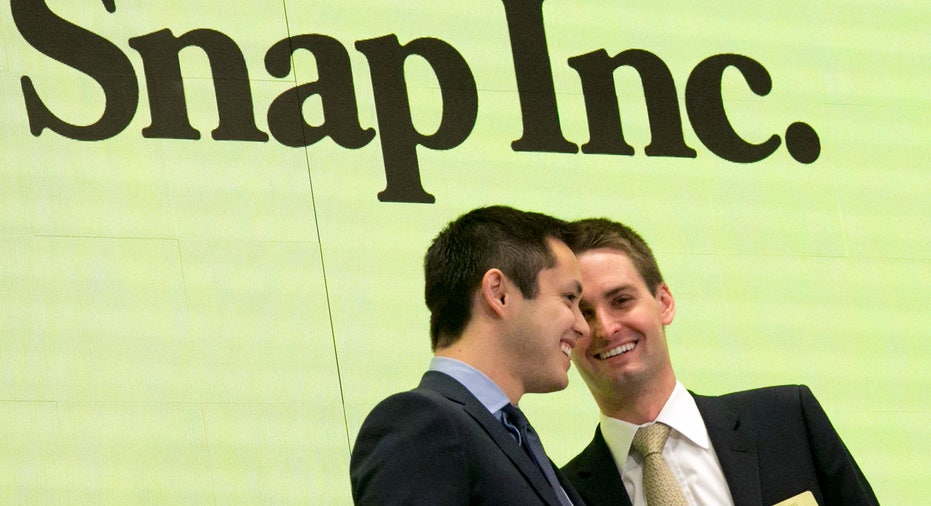Snapchat's growth stalls in Facebook's shadow in 1Q report

NEW YORK – Facebook has been bent on copying Snapchat ever since the social media giant tried unsuccessfully in 2013 to buy what was then an ephemeral photo-messaging app.
Now, the company behind Snapchat is hoping to copy some of its larger rival's own practices, at least with respect to courting new users — and, with them, advertisers.
But it's not going so well.
On Wednesday, Snap Inc. announced a massive loss and a continued slowdown in user growth, while revenue fell below Wall Street's expectations in its first earnings report as a public company. Just a week earlier, Facebook posted double-digit revenue growth for the first quarter — much as it has consistently since its initial public offering in 2012.
Snapchat reported 166 million daily active users in the latest quarter, an increase of just 36 percent from a year earlier. In its first post-IPO report in 2012, Facebook also disappointed investors when its daily user base grew by only 32 percent. But at that point, Facebook had 552 million regular users, more than three times as many as Snapchat.
WHERE THE MONEY WENT
Almost $2 billion of Snap's $2.2 billion loss in the January-March period involved stock compensation costs related to the company's initial offering. Facebook had similar costs of roughly $1.3 billion.
But Facebook's revenue was $1.18 billion in its first quarter as a public company. Although Snap's revenue nearly quadrupled in the latest quarter, it only rose to $150 million. And that still undershot the $158 million analysts polled by FactSet had expected.
Snap's stock fell $5.50, or 24 percent, to $17.48 in after-hours trading.
COPYCATS
Growth in Snapchat's user base began to slow down last year after Facebook's Instagram copied Snapchat's "stories" feature, which lets users post short video clips that disappear after 24 hours. Not to miss out on the trend, Facebook also launched disappearing stories this year.
And let's not forget about WhatsApp, the Facebook-owned messaging service that came out with "status," which lets people post photos and videos that disappear after 24 hours. See a trend here?
ALL ABOUT THE MESSAGING
Matt Britton, CEO of social media marketing company Crowdtap and an expert on millennials, believes Snapchat has "gotten ahead of itself" in pushing out new features, when what it does best — and what it's most used for — is one-on-one messaging.
"If you ask any teen how they use Snapchat, (most) say they use it to text people," Britton said. He said he's seen a lot of teens replace the telephone icon at the bottom of their phones' most-used apps with the Snapchat app. Why call when you can snap, after all?
NOT A SOCIAL NETWORK
Snapchat's Stanford-dropout CEO, Evan Spiegel, has long insisted that his company is not a social network but a "camera company." Unlike Facebook, Twitter or Instagram, Snapchat isn't connecting networks of people. You could use it with just one other person, if you wanted.
Britton sees challenges for Snapchat's non-messaging features, such as stories and a "discover" option that lets users keep up with news, sports or celebrities. These features aren't what many users go to Snapchat for.
Snapchat, like Facebook, is also experimenting with augmented reality, a blending of the virtual and physical worlds, but it's still hard to tell how that will make money or have broad appeal.
In Wednesday's conference call with analysts, Spiegel sought again to distance Snapchat from the likes of Facebook, pointing out that its main focus was not to get as many users to sign up as possible.
"If we had just in the beginning encouraged snapchatters to add all their friends in (their) contact book instead of just few of them, they might be really uncomfortable creating snaps and adding them to their stories," he said, according to a transcript of the call.
GROWING UP
As popular as Snapchat is with young people, they won't be young forever. If the company wants to expand its user base, it will have to broaden its reach to include older people.
"Right now they clearly have a loyal user base in the younger population, but the over 30 year old demographic is one of the most attractive segments for advertisers because of their spending power," Eric Kim, managing partner at venture capital firm Goodwater Capital, wrote in a report.
Teens, though, don't necessarily want to use the same messaging and socializing tools that their parents and grandparents are using. So Snapchat can either keep up with the younger generations and "their evolving behaviors and attitudes," or grow up with its original audience as it ages, said Jessica Liu, an analyst at Forrester Research.
"If they attempt to tackle both, Snapchat will discover that meeting the needs of a 15 year old vs. a 30 year old will be very different," Liu said in an email.
TO COPY OR BUY?
As Facebook keeps copying Snapchat, what can Snapchat do to stay ahead?
"They need to acquire the next Snapchat — companies that are doing one thing right," Britton said. This could be an app such as Houseparty, a group video chat app that's popular with teens, or Musical.ly, a video social network that lets people create and share short music videos.
Of course, Facebook presumably won't be far behind in copying that, either.



















